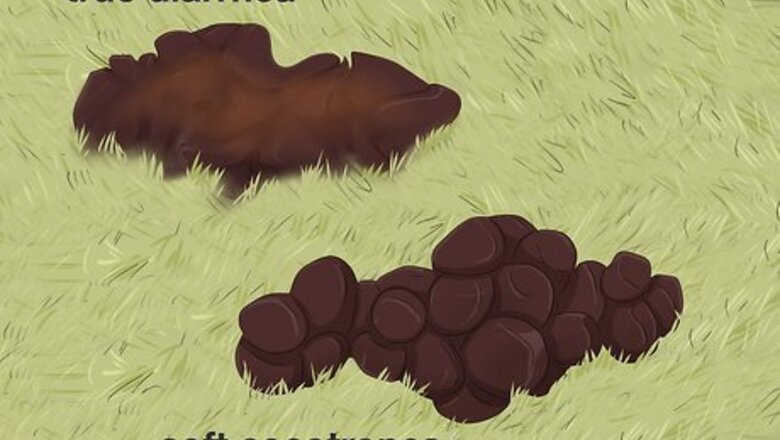
views
- Give your sick rabbit plenty of fresh water and give them medication if your vet recommends it.
- Adjust your rabbit's diet so they're only eating grass hay.
- Include greens in your rabbit's diet once they've had normal bowel movements for a week.
- Help your rabbit stay healthy by keeping them clean, nourished, and relaxed.
Providing Immediate Care
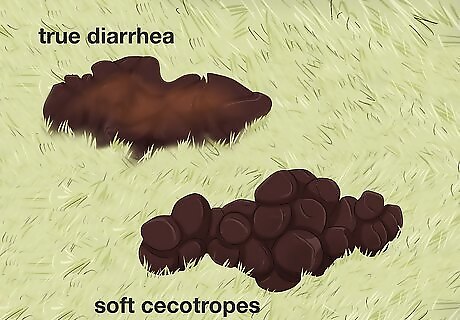
Distinguish between true diarrhea and soft cecotropes. Rabbits have complex digestive systems, and they produce two kinds of droppings. True diarrhea occurs when both the fecal droppings and cecotropes are watery and unformed. If you see normal, hard fecal matter along with other watery droppings, the problem is actually soft cecotropes. True diarrhea is rare in adult rabbits, but sometimes occurs in young rabbits, especially in improperly weaned babies. It's a life-threatening emergency in rabbits of any age. Normal cecotropes look like tiny bunches of grapes, and rabbits need to eat them in order to maintain proper nutrition. Often confused with diarrhea, soft cecotropes are a much more common issue in adult rabbits. Simple dietary changes are often the only necessary treatment. Soft cecotropes are often characterized by a consistency like thick pudding or soft blobs that stick to the rabbit and its surroundings. It is often accompanied by a foul odor.

Bring your rabbit to the vet immediately if it has true diarrhea. If all droppings are watery, call your rabbit's vet, and tell them that your pet is experiencing diarrhea and you're on the way to their office. Diarrhea requires immediate veterinary care, especially in baby rabbits. True diarrhea is often fatal and needs to be taken very seriously. It is usually caused by an alteration of the microorganisms in the cecum (the part of the rabbit's GI tract responsible for fermentation). If you don't already have a vet with experience treating rabbits, search for one online or check the House Rabbit Society's listing: https://rabbit.org/veterinarians/.
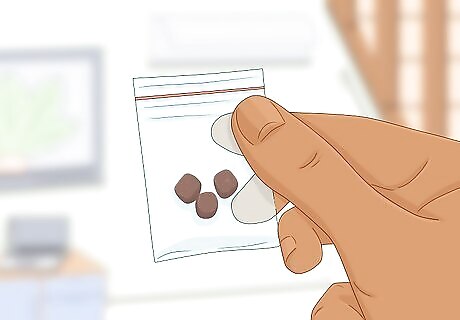
Provide the vet with fresh fecal and cecal samples. The vet will need to take cultures of droppings and examine them under a microscope in order to make an accurate diagnosis. If possible, collect samples of both feces and cecotropes and bring them to the vet. If you can't bring samples with you for any reason, try to take pictures of droppings to show the vet. The vet does not need a large amount for a sample. A sample the size of two to three grapes is plenty. You can transport the sample in a latex glove or zip lock bag to make it easier on the veterinary staff.
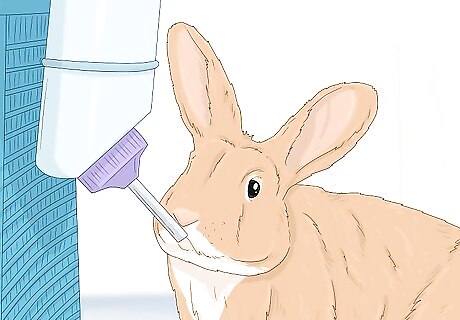
Keep your rabbit hydrated. Dehydration is a major concern, so make sure your rabbit has access to clean, fresh water at all times. If it refuses or is unable to drink, it will need subcutaneous injections of Lactated Ringers Solution to stay hydrated. It's best to have the vet or vet tech administer injections. Molly Varga Molly Varga, Exotics Veterinary Specialist Understanding and treating diarrhea in rabbits requires a comprehensive approach. It's not just about addressing the symptoms, but also about identifying and treating the underlying cause. A sudden change in diet, bacterial or viral infections, or even certain medications can trigger this condition. It's crucial to maintain hydration and ensure that the rabbit continues to eat during the recovery period. In some cases, specific medications to target infections or treatment of an underlying problem may be required.
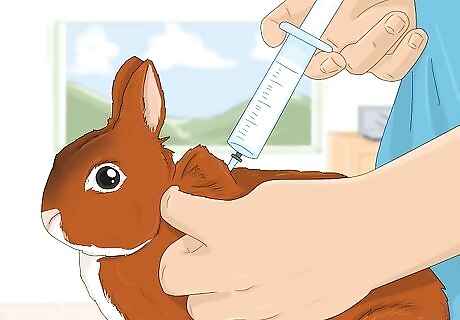
Give hydrating injections yourself if recommended. If a vet professional isn't available and you have the supplies on hand, sterilize the needle and the solution's cap, then draw 1 to 2 mg of the solution. Gently lift the skin to create a tent, and inject the needle at a 45 degree angle. Take care not to push the needle through the other side of the pulled skin, which is very thin. Before injecting the solution, pull the plunger back to make sure you don't draw blood. If you do, you've pierced a blood vessel or muscle and need to choose another site. After injecting the solution, withdraw the needle swiftly and gently along its path of entry. It is not uncommon for the rabbit to have a little “humpback” after subcutaneous fluid administration. Do not worry as this will get absorbed and distributed by the body soon, after which it will disappear. The scruff and flank are the best spots for subcutaneous injection. Administer a total of 10 mg over the course of 24 hours at different sites to reduce tissue damage.
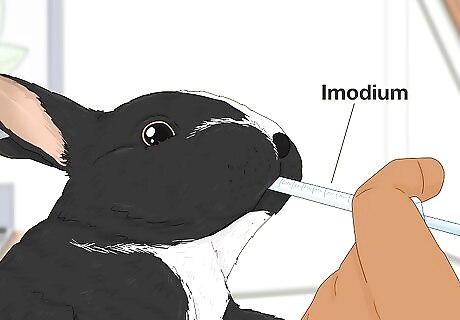
Administer medications according to the vet's instructions. Depending on the vet's findings, they'll prescribe antibiotics to deal with infection. In addition, they will likely instruct you how to administer a number of other medications: Imodium or other anti-diarrhea medication Cholestyramine to treat toxins created by bacteria or parasites Pain relief medication Colostrum to support the immune system of a baby rabbit
Correcting Your Rabbit's Diet
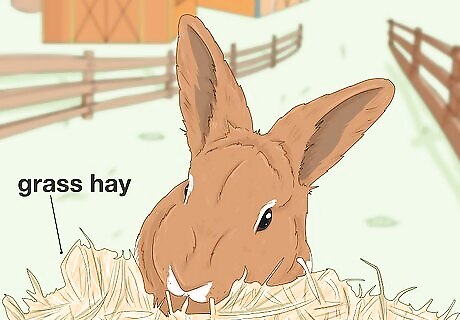
Remove all food items other than grass hay. If your rabbit is used to eating grass hay, stop feeding it all other food. Provide multiple bins throughout its cage to encourage it to eat its hay. Make sure the hay is grass hay and not legume hay, such as alfalfa, which is too rich in carbohydrates and protein. High fiber grass hay is the most important part of a rabbit's diet and is essential for proper digestion. It should return the flora and digestion in the cecum to a normal, balanced state. It should consume only grass hay and water until its droppings return to normal. Make sure the grass hay is fresh and mold free, fresh hay should smell good to you. If the hay is dried out or moldy the rabbit won't eat it.

Switch to grass hay gradually if your rabbit only eats pellets. If your rabbit doesn't normally eat hay, eliminating all other foods could cause starvation. Check the pellets' label to ensure they're based on grass hay. If they are, feed your rabbit pellets twice a day, keep grass hay in its cage at all times, and monitor it to make sure it's eating the hay. Once you see it consistently eating hay, slowly reduce the amount of pellets you feed it over one to two weeks until you've eliminated pellets completely. If it doesn't eat hay, pulverize pellets in a food processor, spray the hay with water, then sprinkle it with the pellet powder.
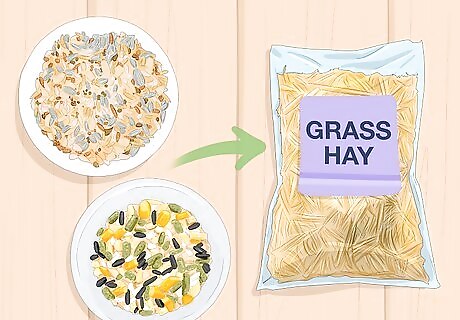
Switch from seed and nut pellets to grass hay pellets if necessary. If the pellets do not contain grass hay, buy a product that does. Feed your rabbit a half and half mix of the old and new pellets. Gradually reduce the amount of old pellets over one to two weeks until you've switched entirely to the new pellets. Once you've switched to grass hay pellets only, introduce your rabbit to real grass hay, then slowly reduce the amount of pellets you keep in its cage.
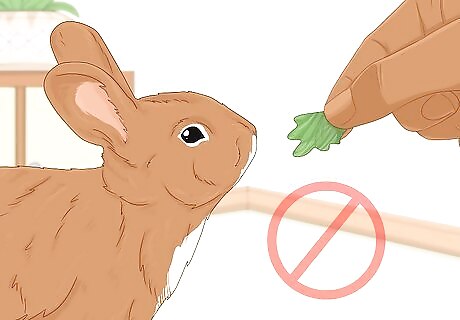
Stop giving your rabbit treats. While your rabbit might seem upset that it's not getting any treats, you must resist the urge to offer them. Rabbits are strict herbivores and their digestive tracts are specialized, so even fruit can cause issues. Further, offering treats will make them less likely to want to eat the hay that they need to get better.
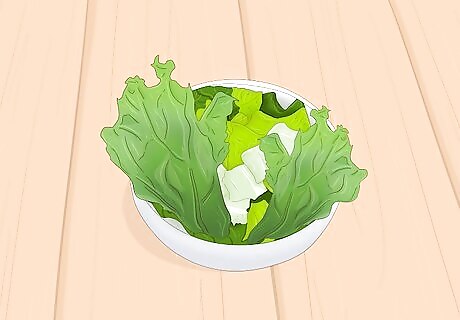
Add greens to its diet after it's had normal droppings for a week. It might take anywhere between two weeks and three months for your rabbit's fecal and cecal droppings to return to normal. After a week of normal droppings, offer a small amount of greens, which will help ensure it's getting all the nutrients it needs. Examples of healthy greens include basil, broccoli, lettuce, kale, and Swiss chard. Darker leafy greens, like kale, are more nutritious than lighter greens, like iceberg lettuce. Feed your rabbit a maximum of one cup (about 150 grams) of one item, then wait 48 hours to make sure it doesn't cause soft cecotropes.
Caring for Your Rabbit During Recovery
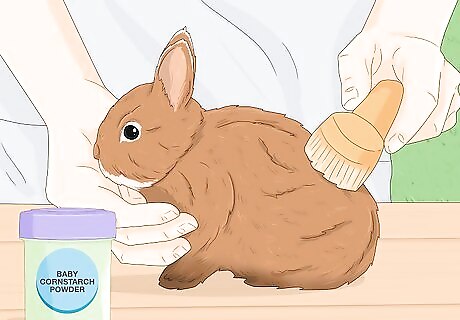
Give your bunny a dry bath. If your rabbit just has some spots of dry droppings in its fur, apply baby cornstarch powder to the soiled areas. Use your fingers and, if necessary, a fine tooth comb to remove the droppings. Gently pat away the powder, but try not to get clouds of powder near your rabbit's face. Use only baby cornstarch powder; don't use talcum or flea powders. Frequent bathing will most likely be necessary during the recovery process. Dry baths are preferable, since rabbits tolerate them better than wet baths.

Give your bunny a wet bath if necessary. If the mess is really wet and smelly, a wet bath is necessary. Fill a sink with warm water and a tablespoon of hypoallergenic, non-medicated shampoo (preferably a product labelled for rabbits). Support your rabbit gently but firmly, so it can't hop away or injure itself, and lower it into the sink until the soiled areas are covered in water. Lather the soiled areas gently, then drain the water. Fill the sink with warm water only and rinse away all soap residue. Alternatively you could try giving your bunny a sponge bath with a washcloth or sponge. It may tolerate this more than being submerged in water. Towel dry your rabbit after rinsing. You can also use a blow dryer on a cool setting.

Make sure it's eating and drinking. Whether the recovery process involves medication or dietary changes, monitor your rabbit's food and water consumption. Take note of how often you've filled food and water containers and try to keep track of how much your rabbit has eaten. Observe your rabbit (from a distance if necessary) as much as possible and note if you consistently see it eating and drinking. Inspect its cage for droppings regularly and note their appearance. Your vet will likely call you for an update or have you bring the rabbit back in for a check up. This kind of information will be important for your vet, so it's good to have it written down and on hand.
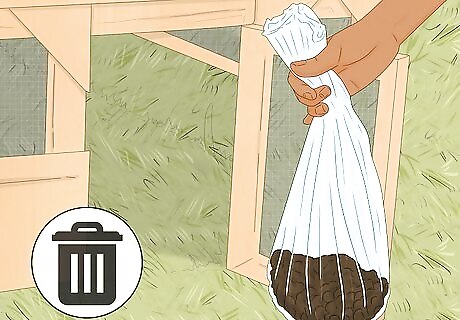
Keep its environment quiet, clean, and stress-free. Rabbits are easily startled, and stressors such as loud noises are bad for their overall health. Maintaining a clean, stress-free environment will be a key part of the recovery process. Keep its cage in a quiet, low-traffic part of your home. Keep small children, other pets, and visitors away from it. A dirty cage can also be stressful, so be sure to keep its cage clean at all times.











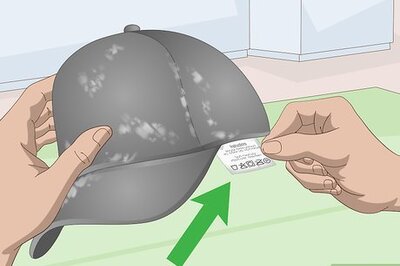


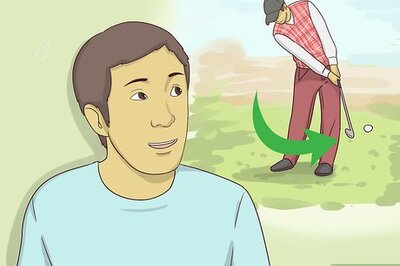
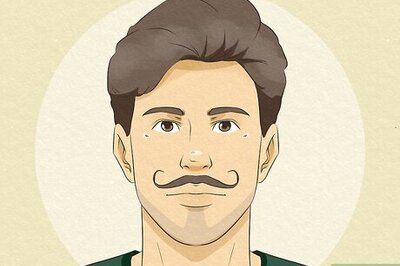
Comments
0 comment